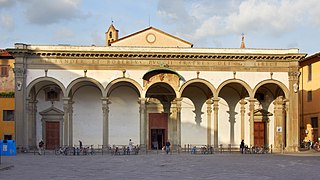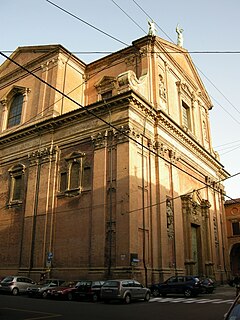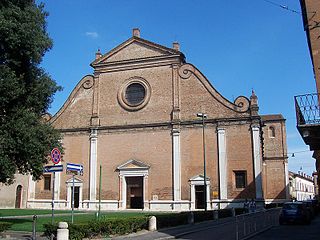Sant'Agostino is a Roman Catholic church, originally founded in the 13th-century but refurbished in the following centuries, located on Corso XI Settembre in the historic center of Pesaro, region of Marche, Italy.

Sant'Agostino is a Roman Catholic church, originally founded in the 13th-century but refurbished in the following centuries, located on Corso XI Settembre in the historic center of Pesaro, region of Marche, Italy.

The eclectic facade has accumulated elements from refurbishments over the centuries. A church at this site was first built in 1258 in a romanesque-style; in 1282 it was assigned to the cloistered Augustinian monks. During the second half of the 14th century, the church was refurbished in a gothic style.
The elaborate ogival entrance portal was erected between 1398 and 1413, under the patronage of the Malatesta dei Sonetti. The iconography contains the lions of the Malatesta coat of arms. A further refurbishment occurred in the 18th century, surrounding the portal with a baroque facade.
The interior retains a 15th-century wooden choir with intarsia, likely built to celebrate the wedding in 1475 between Costanzo Sforza and Camilla d'Aragona. The 32 panels depict buildings restored in the territory by the Sforza. [1]
The church has a number of oval portraits depicting blessed and holy Augustinians, including the blessed Guglielmo and blessed Antonio di Amandola, by Pietro Tedeschi. In addition, a Blessed Caterina da Pallanza, St Giovanni da San Facondo, a Blessed Andrea da Montereale and the Blessed Giuliana da Busto Arsizio are works by Carlo Magini.
The organ, recently restored, was a work of Gaetano Callido (1727-1813). [2] [3]
An inventory from 1864 lists the following artworks in the nave and flanking chapels: [4]

The Basilica della Santissima Annunziata is a Renaissance-style, Roman Catholic minor basilica in Florence, region of Tuscany, Italy. This is considered the mother church of the Servite Order. It is located at the northeastern side of the Piazza Santissima Annunziata near the city center.

The Basilica di Santa Maria Gloriosa dei Frari, usually just called the Frari, is a church located in the Campo dei Frari at the heart of the San Polo district of Venice, Italy. One of the most prominent churches in the city, it has the status of a minor basilica. The church is dedicated to the Assumption of Mary.

Simone Cantarini or Simone da Pesaro, called il Pesarese was an Italian painter and etcher. He is mainly known for his history paintings and portraits executed in an original style, which united aspects of Bolognese classicism with a bold naturalism.

Vincenzo Foppa was an Italian painter from the Renaissance period. While few of his works survive, he was an esteemed and influential painter during his time and is considered the preeminent leader of the Early Lombard School. He spent his career working for the Sforza family, Dukes of Milan, in Pavia, as well as various other patrons throughout Lombardy and Liguria. He lived and worked in his native Brescia during his later years.

Santa Maria in Via Lata is a church on the Via del Corso, in Rome, Italy. It stands diagonal from the church of San Marcello al Corso.

San Nicola da Tolentino agli Orti Sallustiani is a church in Rome. It is referred to in both Melchiori's and Venuti's guides as San Niccolò di Tolentino, and in the latter it adds the suffix a Capo le Case. It is one of the two Roman national churches of Armenia. The church was built for the Discalced Augustinians in 1599, and originally dedicated to the 13th century Augustinian monk, St. Nicholas of Tolentino.

The Basilica of Saint Nicolas of Tolentino is a Roman Catholic church and minor basilica that is part of the Augustinian monastery in the hill-town of Tolentino, province of Macerata, Marche, central Italy. The church is a former cathedral of the Roman Catholic Diocese of Tolentino, suppressed in 1586.

Perugia Cathedral is a Roman Catholic cathedral in Perugia, Umbria, central Italy, dedicated to Saint Lawrence. Formerly the seat of the bishops and archbishops of Perugia, it has been since 1986 the archiepiscopal seat of the Archdiocese of Perugia-Città della Pieve.

Cesare Pronti was an Italian painter of the Baroque period, active mainly near Ravenna.

Santissimo Salvatore is a Baroque-style Roman Catholic church in central Bologna, Italy.

San Francesco is a late-Renaissance, Roman Catholic minor basilica church located on via Terranuova in Ferrara, region of Emilia-Romagna, Italy.
The Church of the Santissima Annunziata is a small Baroque church or oratory located on via dell'Annunziata in central Pesaro, region of Marche, Italy. The deconsecrated church was restored in the year 2000, and the building in 2016 was used for cultural exhibitions and events.

Santa Maria delle Grazie is a Roman Catholic church or oratory located on via San Francesco in Pesaro, region of Marche, Italy.

Sant'Agostino is a Romanesque-Gothic-style Roman Catholic church located in Via Cairoli in Rimini, Italy. It is one of the older extant church buildings in Rimini.
San Giovanni Battista is a church located on Via Passeri #98 in central Pesaro, region of Marche, Italy.
Sant'Agostino is a Roman Catholic church, located on Via Cavour in Mondolfo, region of Marche, Italy.

Sant'Agostino is a gothic-style, Roman Catholic church located in Cremona, region of Lombardy, Italy.

San Barnaba is a deconsecrated Baroque-style, Roman Catholic church, located on Corso Magenta #44, near Piazzale Arnaldo, in Brescia, region of Lombardy, Italy. The church in the 20th century became an auditorium and conference hall, and home of the Conservatorio Luca Marenzio.
San Giovanni is a Gothic-style, Roman Catholic church located in Appignano, province of Macerata, in the region of Marche, Italy.

The Pesaro Altarpiece is an oil on panel painting by Giovanni Bellini, dated to some time between 1471 and 1483. It is considered as one of Bellini's first mature works, though there are doubts on its dating and on who commissioned it. The work's technique is not only an early use of oils but also of blue smalt, a by-product of the glass industry. It had already been used in the Low Countries in Bouts' 1455 The Entombment, but this marked smalt's first use in Italian art, twenty years before Leonardo da Vinci used it in Ludovico il Moro's apartments in Milan in 1492. Bellini also uses the more traditional lapis lazuli and azurite for other blues in the work.
Coordinates: 43°54′42.16″N12°54′38.28″E / 43.9117111°N 12.9106333°E